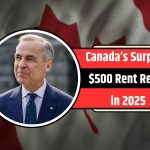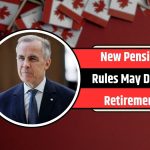Canadian households will soon receive the August 2025 installment of the Canada Carbon Rebate (formerly known as the Climate Action Incentive Payment). This tax-free quarterly payment is issued by the Canada Revenue Agency (CRA) and aims to return a portion of federal carbon pricing revenues directly to residents in participating provinces.
The rebate helps ease the financial burden of rising energy and fuel costs due to Canada’s climate pricing policies. The next disbursement is scheduled for mid-August, offering timely support to households impacted by inflation and higher utility bills.
Automatic Payouts—No Application Required
If you’ve already filed your 2024 personal income tax return, the CRA will automatically issue your August 2025 rebate. Eligible residents will receive the payment through direct deposit or a paper cheque, depending on their selected method.
There’s no separate application process—the CRA uses existing tax return data to determine eligibility and issue payments. This August installment follows a brief pause in July due to administrative updates, and reinstates the standard quarterly schedule for these payments.
Provinces Eligible for the August 2025 Carbon Rebate
The August 2025 Canada Carbon Rebate will be paid to residents of eight provinces where the federal carbon pricing “backstop” is in place. These provinces include:
- Alberta
- Saskatchewan
- Manitoba
- Ontario
- Nova Scotia
- New Brunswick
- Prince Edward Island
- Newfoundland and Labrador
Residents in these provinces will receive their rebates directly from the federal government, as the provincial systems do not manage their own carbon pricing programs.
Rural Residents Get a 20% Top-Up
A major update for 2025 is the increase in the rural supplement, now raised to 20% from the previous 10%. This boost reflects the higher energy demands in rural communities, where alternatives to carbon-intensive fuel are often limited.
The CRA determines eligibility for this rural supplement based on postal code and census data, so no additional application is required. If your residence qualifies as rural, the top-up will be automatically added to your payment.
Snapshot: Canada Carbon Rebate Payment Details
| Category | Details |
|---|---|
| Agency | Canada Revenue Agency (CRA) |
| Payment Name | Canada Carbon Rebate (formerly CAIP) |
| Payment Type | Tax-Free Government Rebate |
| Payment Date | Around August 15–16, 2025 |
| Provinces Covered | 8 Federal Backstop Provinces |
| Mode of Payment | Direct Deposit or Paper Cheque |
| Frequency | Quarterly |
| CRA Portal | canada.ca |
Eligibility Criteria for the August 2025 Carbon Rebate
To qualify for the August 2025 payment, you must meet the following criteria:
- Be a resident of one of the eight eligible provinces
- Have filed your 2024 income tax return, preferably by early April
- Be 19 years or older, or have a spouse/common-law partner or dependent
- Have your rural status registered via CRA systems if applicable
- No income is required—simply filing your return qualifies you
If you haven’t filed your taxes yet, there’s still time, but delays may affect your rebate timeline.
August 2025 Payment Timeline (Province-Wise Breakdown)
The CRA will begin issuing payments around August 15, 2025, though some provinces might see deposits a day later. For example:
- Alberta, Saskatchewan, Manitoba, Ontario: Around August 15
- Nova Scotia, New Brunswick, PEI, Newfoundland & Labrador: Around August 16
Your exact payment date depends on your bank’s processing times and whether you’re receiving a direct deposit or a mailed cheque.
How to Track Your Rebate Payment
To avoid delays and ensure smooth delivery, it’s a good idea to check:
- That your direct deposit information is up to date in your CRA My Account
- That your mailing address is accurate, if receiving a cheque
- That your rural designation, if applicable, is correctly recorded
You can log into the CRA My Account portal to view your eligibility status, deposit dates, and any messages or alerts regarding your payment.
Why the Canada Carbon Rebate Is Crucial for Households
The Canada Carbon Rebate serves as financial relief for households coping with the rising costs of carbon pricing. According to federal estimates, most households receive more through the rebate than they pay in carbon tax—many recouping close to 80% of the added expenses.
Beyond financial support, the program also contributes to Canada’s climate goals. By redistributing carbon revenues directly to residents, it incentivizes energy-conscious behaviors without placing an undue burden on families.
The August 2025 installment comes after a brief delay in July and reflects an improved administrative process designed to deliver payments more efficiently and consistently moving forward.
What Should You Do Before August 15?
If you want to ensure your August 2025 Canada Carbon Rebate arrives without issues, here’s a quick checklist:
- File your 2024 tax return
- Confirm your banking details are updated on CRA My Account
- Ensure your residential address and rural designation are correct
- Watch for deposit notifications or mailed cheques by mid to late August
- If you don’t receive your payment, check CRA messages or call support
Taking these simple steps can help you avoid unnecessary delays and receive your rebate on time.
A Program That Supports Both Wallets and the Environment
The Canada Carbon Rebate isn’t just a financial tool—it’s a key element of the government’s climate response. It ensures that Canadians aren’t penalized financially while the country transitions toward more sustainable energy practices.
By distributing carbon tax proceeds back to households, the government supports both climate responsibility and economic stability.
The August 2025 payout offers crucial support during back-to-school season, summer utility spikes, and ongoing inflation challenges—making a real difference for working families, seniors, and rural Canadians.
Frequently Asked Questions (FAQs)
Q1. When will I receive my Canada Carbon Rebate payment in August 2025?
Most eligible residents will receive their payment on or shortly after August 15, 2025. Those in Nova Scotia, PEI, New Brunswick, and Newfoundland and Labrador may receive it by August 16, depending on CRA scheduling and banking timelines.
Q2. Do I need to apply for the 20% rural top-up?
No. The CRA uses your postal code and census data to determine if your residence qualifies as rural. If eligible, the 20% supplement is added automatically—no application needed.
Q3. Can I still get the rebate if I didn’t earn income in 2024?
Yes. You do not need to have earned income to qualify. As long as you file your 2024 tax return, you’re eligible to receive the rebate—even if your reported income is zero.
Q4. What if I haven’t received my rebate by late August?
Check your CRA My Account for updates, messages, or status changes. If no updates are available, you may also contact CRA support for clarification.
Q5. What’s the purpose of the Canada Carbon Rebate?
The rebate helps offset the financial impact of federal carbon pricing, particularly for low- and middle-income households. It’s also part of Canada’s climate change strategy, promoting responsible energy use without increasing household costs.









